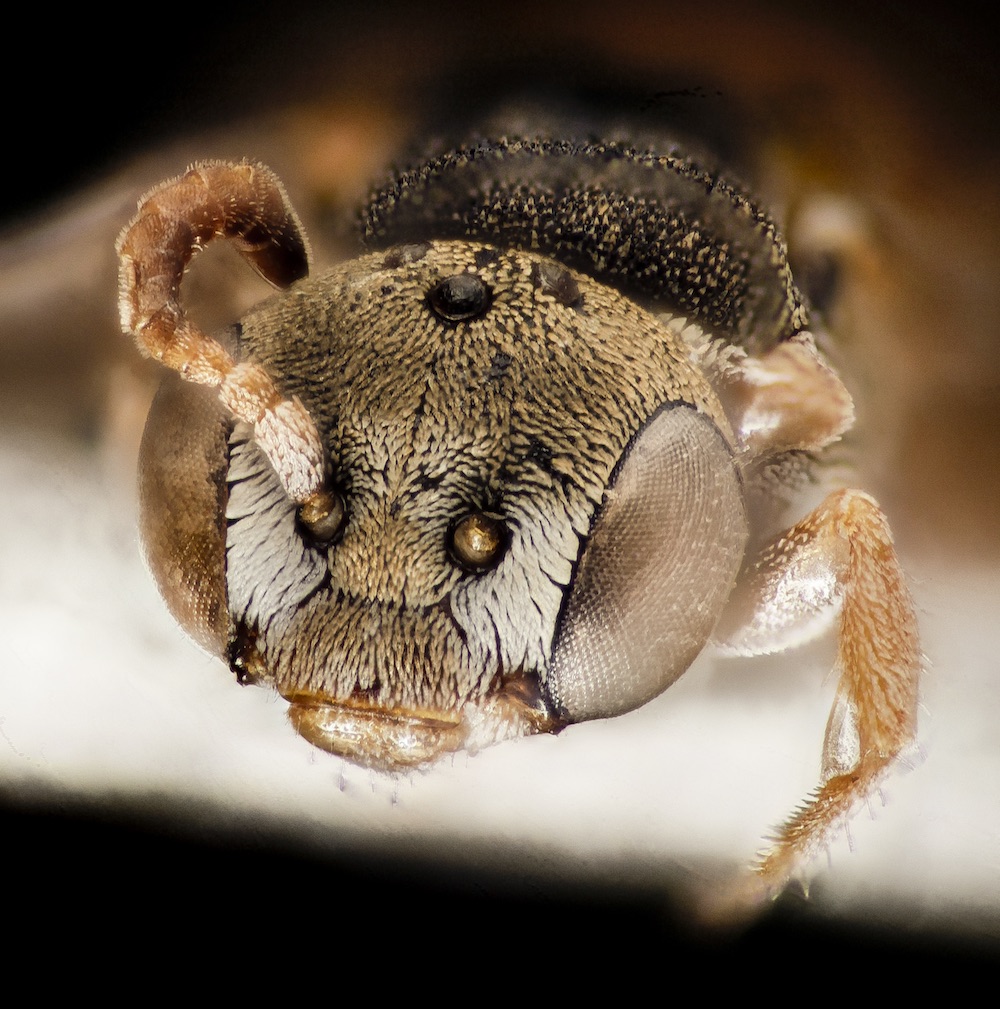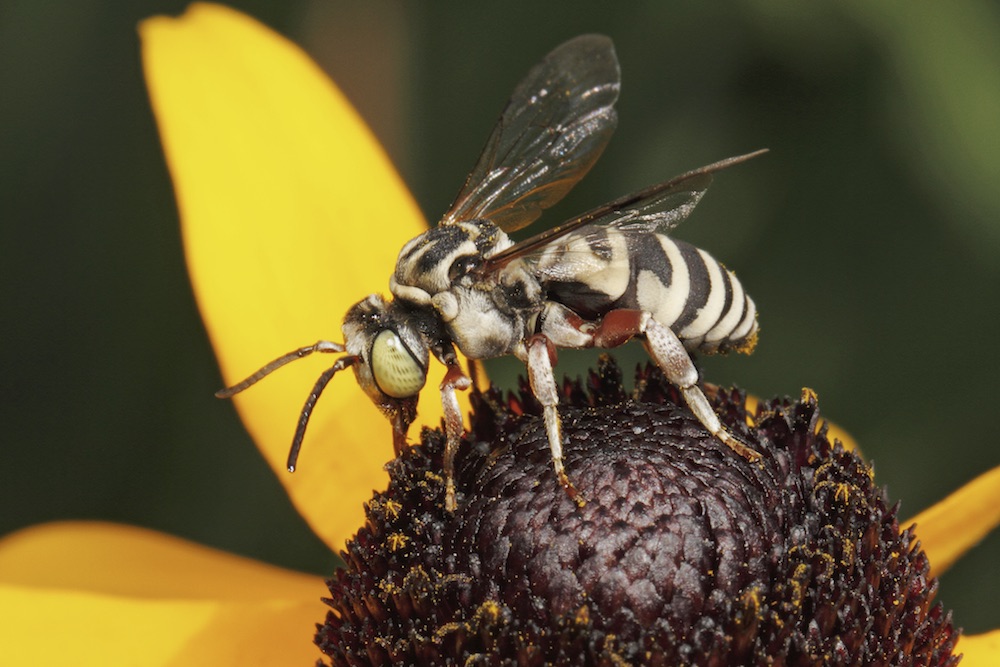Death And Thievery In The Colony
Cleptoparasite female bee, in the nest, with the manacles.

The following is an excerpt from Our Native Bees by Paige Embry.
The tiny bee flits about, just above the ground. Clothed in a tightly pressed suit of gray hairs, it is scarcely visible—a ghost bee. Of course, given that the bee is maybe half the size of an uncooked piece of rice, it could be bright red and still go unnoticed. The little bee may rest in the heat of the afternoon, head down on the shady side of a stem. At some point, if the bee is female, she stops flitting, having found what she’s been looking for. She dives into the hole of another minuscule bee, one of the large genus Perdita. The goal of the ghost bee is theft and ultimately death. Her plan is to hide her egg in the cell of the host bee. Her offspring will hatch, kill the host bee’s young, and consume all the provisions laid down by the hard-working host mother. North America may have a dozen or more species of Neolarra. All are cleptoparasites, those who thieve and kill rather than gather and provision.

Our Native Bees: North America’s Endangered Pollinators and the Fight to Save Them
I put together this description of Neolarra pruinosa based on a paper written in 1965, not long after I was born. I’ve never seen a Neolarra of any species flit about or hang from a stem. I’ve only seen one dead on a pin, but I still find it mesmerizing in its smoky grayness. I wonder what this little Neolarra and all the other cleptoparasites do in the dark of the nest. Fortunately for me, every day I’m at the Southwestern Research Station I find myself in the car with the guy that wrote that paper, Jerry Rozen, so I’ll get my chance to find out.
Nobody likes the idea of parasites. Thoughts of ticks and nasty intestinal worms tend to come to mind. But parasites are everywhere, and scientists have found that, generally speaking, they are beneficial. Not for the individual dealing with the parasite, naturally, but for the ecosystem as a whole. Usually, we think of parasites as evil outsiders. Bees are attacked by those kinds of parasites, like the vile Varroa destructor mites that destroy honey bee colonies, but about fifteen percent of bees are parasites of their own kind. Somehow, that seems much ruder than being preyed upon by some Other. You don’t expect your cousins to turn on you.
The nature of bee parasitism is surprisingly variable. A particular parasitic bee is often picky, going after one bee species or a small group of closely related bees. For bumble bees, the primary method is for the parasite to kill off the queen, take her place, and have the former queen’s daughters raise her eggs. I often see them called cuckoo bees, whereas the bee parasites of solitary bees are usually referred to as cleptoparasites—thieves and parasites. My adorable little Neolarra is one of these thieving killers.
One day, as we are driving, I ask Jerry about Neolarra. “How does it attack the Perdita [its host]?”
“It doesn’t attack the Perdita,” he responds. “It enters the nest of the Perdita when the Perdita female isn’t there.”

Jerry admits that he hasn’t worked much with Neolarra (and his paper on them was written more than fifty years ago), but he assumes it acts like most parasitic bees. He goes on and tells me about Oreopasites, a close relative of Neolarra. (I put together the following description from what Jerry tells me in the car and some research papers.)
A cleptoparasite female, with eggs ready to lay, scouts for a likely nest entrance. At least some seem to recognize where they need to be by smell. The cleptoparasite mom flits around or finds a handy perch and keeps an eye on things. She sees a bee come out of a hole. Here’s her moment. Provisioning a nest cell for an egg usually takes multiple trips, so chances are the cell is open and partially full. The clepto mom zips in, finds the partially filled nest cell, and usually hides the egg in some way.
According to Jerry, the egg is usually partly buried in the cell wall. If the host bee comes back and finds it, she’ll dig it out with her mandibles and kill it. I confess that I’m surprised the host bees don’t routinely find and kill these eggs, given the small size of the nest cells. Jerry replies, “They have to find the egg. And you know what? They don’t have a flashlight.”
Some parasitic bees attack the host as soon as they get their head out of the egg, sucking the life out of the host egg. Then they can finish hatching at their leisure and eat up the pollen reserves meant for their fallen foe.
Other kinds of parasitic bees do things differently. They don’t look for a partially provisioned cell, but instead hunt for one that’s just been closed: no host mama bee to return and potentially find the hidden egg. These cleptoparasite moms make a hole with their mandibles big enough to stick their abdomen in. Then they lay an egg and cover their tracks. A few parasitic mama bees kill the host egg, but most often it is up to the young larva to deal with the host bee baby themselves, and these parasitic larvae are built for killing.
When most bee larvae hatch, they are helpless white grub-like things. They lie on their food, eat, and grow. Because they are insects, they periodically molt (shed their exoskeleton). Each stage between a molt is called an instar, and bees generally have four or five of them. The first instar of most parasitic bees emerges looking very different from a non-parasitic bee. It is not a helpless white grub-like thing. It is a white grub-like thing with sharp mandibles and strong head muscles, the better to bite and kill with. Cleptoparasites are said to be hospicidal—host killers. In addition to the physical equipment needed to slay the hosts, they also need a hospicidal nature.
According to Jerry, some parasitic bees attack the host as soon as they get their head out of the egg, sucking the life out of the host egg. Then they can finish hatching at their leisure and eat up the pollen reserves meant for their fallen foe. Most cleptoparasites, however, wait until they’ve completely hatched before dispatching their cell mates. The extra strong jaws and mandibles aren’t really needed after the parasite has killed the host, so the following instars usually look more like a normal bee larva. Sometimes more than one cleptoparasite mom lays an egg in a cell, so not only does a parasite larva kill the relatively helpless host, it may have to do battle with others of its kind. Presumably, the first one to hatch has a big advantage here.

Sometimes though, it’s not the first instar that does the killing.
The cleptoparasite Stelis ater may kill the host at any stage in its development. It all depends on when it encounters the host bee, because neither larva can move. (Many cleptoparasite larvae can.) In one study of these bees, the researchers found a fifth instar cleptoparasite munching away on the pollen wad right next to the fourth instar of the host. About an hour later, the cleptoparasite had clearly found the host because it had taken to chewing on it instead. Hospicidal nature indeed.
Even more surprising is little Leiopodus singularis, a cleptoparasite of Diadasia olivacea. Researchers observed these bees happily going about their business right at the Southwestern Research Station. They found that Leiopodus singularis would often perch outside the nest area of Diadasia with an air of “furtive alertness.” Sometimes a Leiopodus female would go down a hole and be back in short order, maybe twenty seconds. Other times, the bee was gone for around two minutes, and the researchers assumed that during these longer visits she laid an egg. After these visits, most of the Leiopodus bees would perch and preen for about thirty seconds, then fly off. I thought this was a “Yay, go me, I laid an egg” kind of preening, but the researchers thought it was likely to be merely cleaning up after being in a strange nest. I suppose it’s like washing your hands after touching someone else’s stuff.
Where things get really interesting with this bee is with the larvae down in the nest. Leiopodus singularis has a long incubation period. When it hatches, the puny little one-millimeter first instar is confronted with a gigantic third or fourth instar (ten to twelve millimeters) of the host, which it promptly kills. That little instar has fangs and is a mighty crawler, despite having no legs. Somehow those two features, and presumably a generally murderous nature, allow it to dispatch its massive foe and eat up the rest of the food provisions.
When Jerry told me this story, I asked how on earth he knew that the first instar killed the fourth? He’d dug up nests, and there they were: little first instars sharing a cell with their slain fourth instar rivals.
Taken from Our Native Bees © Copyright 2018 by Paige Embry. Published by Timber Press, Portland, OR. Used by permission of the publisher. All rights reserved.
Paige Embry is author of Our Native Bees: North America’s Endangered Pollinators and the Fight to Save Them (2018, Timber Press). She’s based in Seattle, Washington.